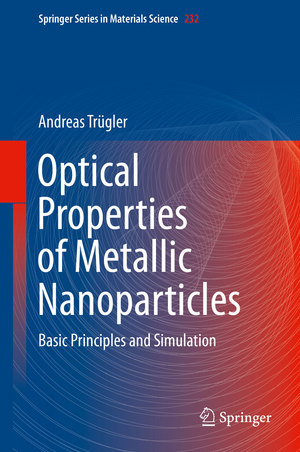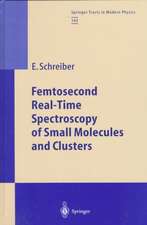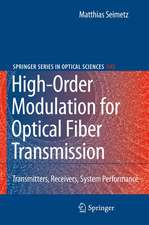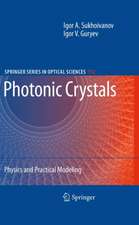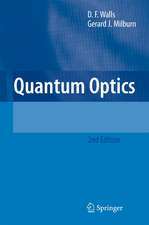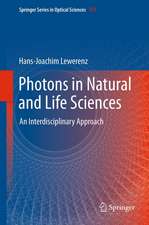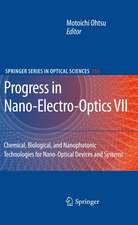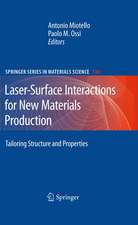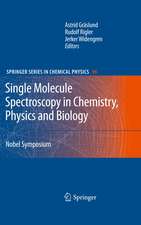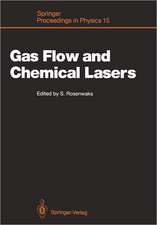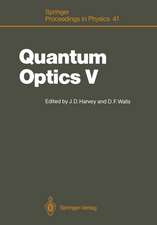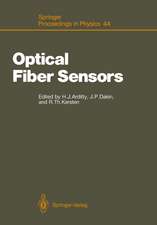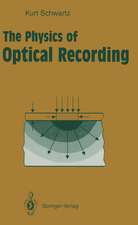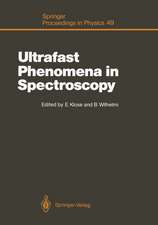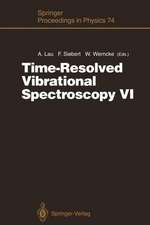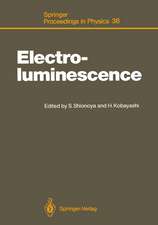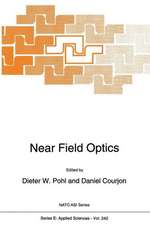Optical Properties of Metallic Nanoparticles: Basic Principles and Simulation: Springer Series in Materials Science, cartea 232
Autor Andreas Trügleren Limba Engleză Hardback – 6 apr 2016
| Toate formatele și edițiile | Preț | Express |
|---|---|---|
| Paperback (1) | 575.56 lei 6-8 săpt. | |
| Springer International Publishing – 19 apr 2018 | 575.56 lei 6-8 săpt. | |
| Hardback (1) | 730.02 lei 6-8 săpt. | |
| Springer International Publishing – 6 apr 2016 | 730.02 lei 6-8 săpt. |
Din seria Springer Series in Materials Science
- 18%
 Preț: 1820.22 lei
Preț: 1820.22 lei - 18%
 Preț: 776.09 lei
Preț: 776.09 lei - 24%
 Preț: 689.69 lei
Preț: 689.69 lei - 18%
 Preț: 968.96 lei
Preț: 968.96 lei - 20%
 Preț: 568.95 lei
Preț: 568.95 lei - 18%
 Preț: 953.65 lei
Preț: 953.65 lei - 18%
 Preț: 902.36 lei
Preț: 902.36 lei - 18%
 Preț: 953.65 lei
Preț: 953.65 lei - 20%
 Preț: 948.42 lei
Preț: 948.42 lei - 18%
 Preț: 1143.07 lei
Preț: 1143.07 lei - 18%
 Preț: 1111.53 lei
Preț: 1111.53 lei - 18%
 Preț: 1103.62 lei
Preț: 1103.62 lei - 18%
 Preț: 1225.94 lei
Preț: 1225.94 lei -
 Preț: 473.91 lei
Preț: 473.91 lei - 18%
 Preț: 782.42 lei
Preț: 782.42 lei -
 Preț: 433.47 lei
Preț: 433.47 lei - 18%
 Preț: 1116.40 lei
Preț: 1116.40 lei - 18%
 Preț: 946.24 lei
Preț: 946.24 lei - 18%
 Preț: 945.20 lei
Preț: 945.20 lei - 18%
 Preț: 1114.21 lei
Preț: 1114.21 lei - 15%
 Preț: 641.20 lei
Preț: 641.20 lei - 18%
 Preț: 958.56 lei
Preț: 958.56 lei - 18%
 Preț: 1224.36 lei
Preț: 1224.36 lei - 15%
 Preț: 644.82 lei
Preț: 644.82 lei - 24%
 Preț: 833.45 lei
Preț: 833.45 lei - 24%
 Preț: 1060.36 lei
Preț: 1060.36 lei - 18%
 Preț: 964.10 lei
Preț: 964.10 lei - 18%
 Preț: 1224.36 lei
Preț: 1224.36 lei - 18%
 Preț: 1221.20 lei
Preț: 1221.20 lei - 18%
 Preț: 946.87 lei
Preț: 946.87 lei - 18%
 Preț: 1836.92 lei
Preț: 1836.92 lei - 15%
 Preț: 643.34 lei
Preț: 643.34 lei - 18%
 Preț: 1246.32 lei
Preț: 1246.32 lei - 18%
 Preț: 956.81 lei
Preț: 956.81 lei - 18%
 Preț: 953.52 lei
Preț: 953.52 lei - 15%
 Preț: 637.59 lei
Preț: 637.59 lei
Preț: 730.02 lei
Preț vechi: 890.27 lei
-18% Nou
Puncte Express: 1095
Preț estimativ în valută:
139.68€ • 145.86$ • 115.35£
139.68€ • 145.86$ • 115.35£
Carte tipărită la comandă
Livrare economică 15-29 aprilie
Preluare comenzi: 021 569.72.76
Specificații
ISBN-13: 9783319250724
ISBN-10: 3319250728
Pagini: 200
Ilustrații: XIX, 217 p. 100 illus., 98 illus. in color.
Dimensiuni: 155 x 235 x 19 mm
Greutate: 0.51 kg
Ediția:1st ed. 2016
Editura: Springer International Publishing
Colecția Springer
Seria Springer Series in Materials Science
Locul publicării:Cham, Switzerland
ISBN-10: 3319250728
Pagini: 200
Ilustrații: XIX, 217 p. 100 illus., 98 illus. in color.
Dimensiuni: 155 x 235 x 19 mm
Greutate: 0.51 kg
Ediția:1st ed. 2016
Editura: Springer International Publishing
Colecția Springer
Seria Springer Series in Materials Science
Locul publicării:Cham, Switzerland
Public țintă
ResearchCuprins
Part I: Introduction and Basic principles.- Prologue.- The world of plasmons.- Theory.- Part II: Simulation: Modeling the optical response of metallic nanoparticles.- Part III: Implementations and applications.- Imaging of surface plasmons.- Influence of surface roughness.- Nonlinear optical effects of plasmonic nanoparticles.- Nonlocal response.- Metamaterials.- Outlook.- Part IV: Supplement.- Appendix - Utilities.- Appendix - MATLAB script for Mie solution.
Notă biografică
Mag. Dr. Andreas Trügler
Institut für Physik, Fachbereich Theoretische Physik
Karl-Franzens-Universität Graz
Institut für Physik, Fachbereich Theoretische Physik
Karl-Franzens-Universität Graz
Textul de pe ultima copertă
This book introduces the fascinating world of plasmonics and physics at the nanoscale, with a focus on simulations and the theoretical aspects of optics and nanotechnology. A research field with numerous applications, plasmonics bridges the gap between the micrometer length scale of light and the secrets of the nanoworld. This is achieved by binding light to charge density oscillations of metallic nanostructures, so-called surface plasmons, which allow electromagnetic radiation to be focussed down to spots as small as a few nanometers. The book is a snapshot of recent and ongoing research and at the same time outlines our present understanding of the optical properties of metallic nanoparticles, ranging from the tunability of plasmonic resonances to the ultrafast dynamics of light-matter interaction. Beginning with a gentle introduction that highlights the basics of plasmonic interactions and plasmon imaging, the author then presents a suitable theoretical framework for the description of metallic nanostructures. This model based on this framework is first solved analytically for simple systems, and subsequently through numerical simulations for more general cases where, for example, surface roughness, nonlinear and nonlocal effects or metamaterials are investigated.
Caracteristici
A clear and detailed introduction to plasmonics as applied to metallic nanoparticles Emphasizes computational approaches, while also demonstrating the important interplay between theory and experiment Extensive references give the reader the basis for further exploration of the field
